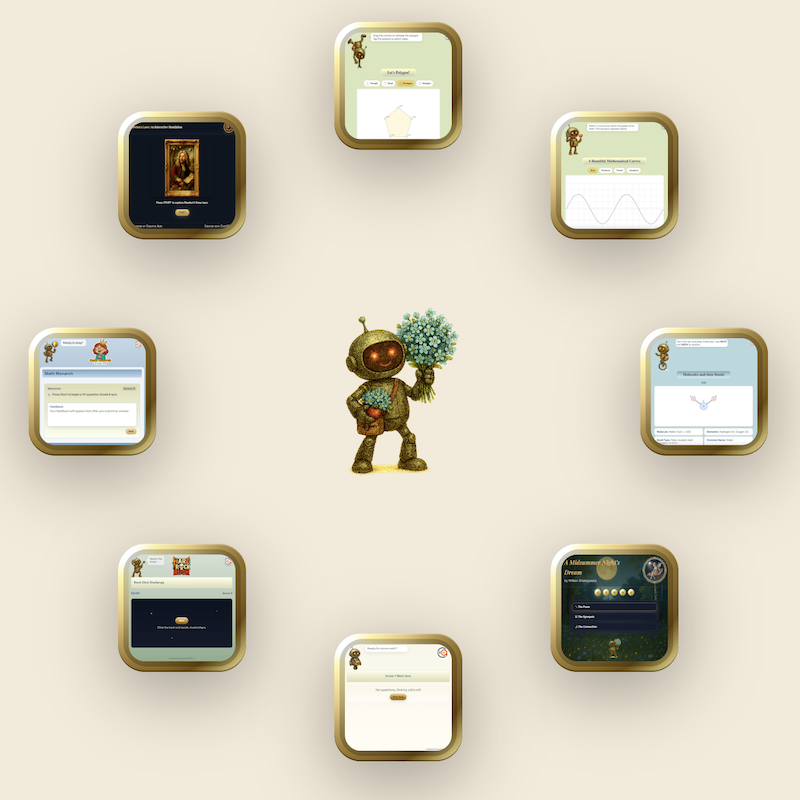(Note: This article is based on some experimental reconnaissance of the AI paradigm and how it is set to impact content creation.)
Let me begin by explaining a few key terms as non-technically as possible…and of course, with a warning – I am an instructional designer and my programming capabilities are fairly limited. I could once write a bit of code in ActionScript (the programming language of then Macromedia/Adobe Flash, now Adobe Animate,) and I am pretty sure that I have neither the hyper-organized mind nor the savvy-smarts to do any sort of useful programming.

Now about those key terms…
AI-related Key Terms:
AI or Artificial Intelligence:
Artificial intelligence is intelligence that’s not natural (or human) but that mimics human intelligence. Since none of the other beings inhabiting this planet are smart enough to even mimic human intelligence, computers are being programmed by humans to learn, think, and behave the way humans do and this is known as artificial intelligence.
Machine Learning:
Machine learning refers to the way computers (machines) learn and even become better at learning. Since the AI programmers want the computers to imitate how humans learn, machine learning too is based on pattern-recognition. However, machine learning requires that a human “teaches” the machine.
Deep Learning:
Machines are being programmed to auto-learn or learn on their own. So given a data-dump, a machine doing deep learning, would have the ability to see patterns on its own. It would achieve this through several layers of networks, and quite like the way we humans self-learn, deep learning machines too learn by receiving (and processing) the inputs they get from their environment (users.)
NLP/NLG:
NLP is the Natural Language Processing framework, which is used by computers to process human inputs given in the natural human language (for instance, all voice recognition happens through NLP.) NLG or Natural Language Generation frameworks allow the computers to generate content in natural human language, written or spoken.
(I think this bit suffices for us to take our discussion forward. In case you want to read more on it, I suggest checking out https://www.ibm.com/cloud/learn/machine-learning, which I think is a comprehensive resource on this topic.)
 Armed with this basic terminology, let us look around and see what AI is accomplishing.
Armed with this basic terminology, let us look around and see what AI is accomplishing.
AI is being used in digital marketing, content writing, robotics, facial and voice recognition, and a plethora of other areas. You can read about the application areas of AI or Artificial Intelligence here.
The areas that most affect us (the learning providers) are:
- Content Writing
- Videos
- Voice Recognition and Content Generation
- Visual Design
- Performance & LMS Data Analytics
I know that I won’t be using AI to create art or write content for me, but since I wanted to assess their capabilities, I checked out a few tools.
- Content Writing
AI Copy, ChatGPT, Grammarly, and Quillbot
- Videos
- Voice Recognition and Content Generation
- Visual Design (AI Art)
Google’s Deep Dream Generator, Starry AI, and Dall-E
Frankly, my experiments left me in awe. I realized that AI is becoming stronger by the day, and that the AI-buzz is by no means a fad that will pass away. I think it’s here to stay especially since it’s going to be make content creation a lot cheaper for corporations and online institutes.
 Here’s my takeaway:
Here’s my takeaway:
AI – Current State & Future Direction:
Content Writing:
As of today, AI can generate acceptable content against general prompts – but when a prompt becomes too specific, it ignores the specific requirement and continues to provide generic answers.
A few months back, I had written an article, “The What, Why, and How of Assessment Rubrics” in the Feb/March 2022 Issue of The FOUNT (Creative Agni’s Magazine for the ID and eLearning Professionals.)
Here’s my experience with AI attempting the same task.
When I ask it to “Explain Assessment Rubrics with an example,” the output isn’t too bad. The AI provides an explanation (with only a small error,) lists three criteria and shows how the performance against each of these could be graded. However, it doesn’t use a specific example (something that any good instructional designer would provide.)
When I changed the prompt to “Explain Assessment Rubrics using an Essay on The Merchant of Venice,” it “lost” confidence (it sure felt like it did) and provided a four paragraph generalized answer.
An Instructional Designer would ask relevant questions (about audience profile, prior learning etc.) and then map the example with the concept to ensure that the concept of assessment rubrics is clearly understood by the learners.
I think with Deep Learning becoming the norm for most AIs, we’ll soon see it evolving in terms of specialization. Quite like a hundred years ago, all Doctors were Generalists, and now most are Specialists – in not too distant a future, we should have specialist AIs. Given an Instructional Design framework that’s accurately designed to be used by AI, it should be able to create learning content as well – especially with all those billions of information pieces at its digital fingertips…it should be able to do a reasonably good job.
Language-Processing/Voice Recognition/Videos:
Artificial Intelligence is already making great strides in these areas. I am not sure of videos yet, but if the capabilities of the likes of ChatGPT and Synthesia were put together, given a prompt, AI could create a video of someone lecturing on say, Global Warming…and nobody would be able to say that it was AI-content. The video-generator AI would soon be generating a realistic looking person based on the looks that the audience likes, speaking text generated by another AI in a voice that the audience finds pleasing. Each of these is already being done separately. AI is noticing what kind of faces and personalities we like, what we shop for, what music we like listening to…and so on. (At this point, I’d recommend watching the movie SuperIntelligence.)
Visual Design:
Our artificially intelligent colleague is already perfecting what I call cosmetic graphics or graphics that are used to make content look prettier. I’ve tried using StarryAI, DALL-E, and a couple of other AI-Art apps – and I think that when it comes to creating graphics as per specifications/requirements – AI still has a long way to go.
 In a nutshell,
In a nutshell,
I recommend that those in the content industry should be watching the growth of AI very closely. Yes, AI is a great tool, but as my industry colleague Aswin said in our recent clubhouse discussion, “this tool has the potential of becoming the master.”
I see AI replacing badly written content on the Internet. I also see AI continuously improving itself, something that we humans often stop doing once we become comfortable…and I see AI training itself on specialized frameworks (introduced by humans, of course,) and I hope that we have a few years before it happens. I also have a feeling that quite like there’s a law against cloning humans (Article 11 of the Universal Declaration on Human Genome and Human Rights adopted by UNESCO on 11 November 1997), international authorities will probably try to slow down the exponential growth of AI.
We’ll see.
For now, my advice to the Instructional Design Community is quite simple really.
Master your craft to an extent that AI finds it difficult to catch up with you.
It should help us keep our heads above water until the next generation arrives with a whole new set of jobs, possibly with a gamut of new titles such as, “AI Content Auditors,” “AI-Human Interface Expert,” “Human-speak Authenticity Evaluators” and so on.
A whole new arena of possibilities lie unexplored beyond the AI frontiers. Remember that every thrilling adventure is made of carefully measured and structured risks – and without those risks, this world will be an exceptionally boring place.
Image Credit:
AI (of course) created them using the StarryAi app – with the following info:
Prompt: Artificial intelligence will take away content writing jobs
It provided me the following text that it “probably” used to create the images.
beautiful watercolor painting, realistic, detailed, painting by olga shvartsur, svetlana novikova, fine art, soft watercolor, futuristic, chinese watercolor, surrealism
I selected the terms (art-movements/painting styles etc.) that you see in bold letters. It automatically selected the rest (including the names of the artists “Olga Shvartsur” and “Svetlana Novikova” and I can see their styles reflected in the AI-art(?) that I’ve included in this post.
Although the four AI graphics that I’ve included here don’t have the kind of content-relevance that I had hoped for, they have a certain aesthetic appeal. I also wonder why each has a woman’s face in it as I didn’t specifically ask for a female face in my prompt. It’s clear that AI has “learned” to become somewhat biased to favor women subjects in art (it doesn’t surprise me because it learns from the paintings it finds,) and in that, it’s quite like humans 🙂 (Pun intended.)
Be My Guide, Shine the Light – Creator-AI Codependency?
And you know what’s the weirdest bit?
Yoast Plugin, which I believe is artificially intelligent, told me that my vocabulary might not be suited for a larger audience and that my sentences are too long. It also reminded me to use sub-headings for better SEO and gave me a figurative pat on back (“Great Job!”) when I used its suggestions and conformed. So far AI condescends to allow posting of content that doesn’t come up to its exacting standards (I didn’t take its advice on the vocabulary and the length of the sentences) but what if it didn’t? I shudder to think of the day it might happen.
What about you?
Would you feel bound and gagged if it didn’t allow to make your post until you checked all the boxes?





December 27, 2022 at 5:35 am
I love this post.
December 27, 2022 at 6:06 am
Thanks Suchita. Do share your thoughts on the impact of AI too. Let us bring more POVs to this discussion.